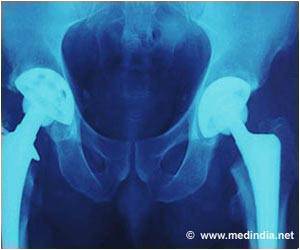Doctors have been selecting younger and healthier patients for the bilateral procedure because there are more risks with having a total knee replacement in both legs then in one leg.

"Although we are selecting younger people, we can't ignore the fact that the population in general is getting sicker," said Stavros Memtsoudis, M.D., Ph.D., director of Critical Care Services at Hospital for Special Surgery (HSS) in New York City, who led the study. "Many of the complications that we studied didn't decrease over time as you would expect with younger patients and better health care, and some of the complications even increased." The study is published online ahead of print in the journal Clinical Orthopaedics and Related Research.
Rising levels of obesity appear to be driving the complication rates, as well as the increase in the utilization of total knee replacements. Obesity puts extra stress on joints and bones and can cause premature osteoarthritis.
To conduct their research into trends regarding bilateral total knee replacements, researchers at HSS turned to the Nationwide Inpatient Survey, sponsored by the Agency for Healthcare Research and Quality (AHRQ). This is the largest inpatient database available in the United States that includes information on patients of all ages. It collects data from about 20% of all hospitalizations in the U.S. The study investigators identified 258,524 bilateral total knee replacements performed between 1999 and 2008. The number of annual bilateral procedures increased by 75%. In 1999, bilateral procedures accounted for 3.7% of all knee replacement operations and in 2008, they accounted for 6% of the operations.
The average age of patients undergoing bilateral knee replacement decreased by 2.5 years from 1999 to 2008. As the years marched on, patients presented with higher rates of comorbidities, including renal failure, neurologic disease, liver disease, diabetes, and chronic obstructive pulmonary disease. Obesity increased by 131% during the study period. The only comorbidity that decreased was congestive heart failure.
Over the time period studied, the researchers identified a 3% increase in pneumonia, a 6% increase in pulmonary embolism, and a 3% increase in nonmyocardial infarction cardiac complications.
Advertisement
On a positive note, the investigators also found that absolute in-hospital mortality rates decreased at an average rate of 10% per year. The researchers attribute this decrease to advances in medicine and increased use of telemetry and observation in the last 10 to 15 years. "With advances in medicine and monitoring, we have been able to counteract this extreme event of mortality. If you get a complication and it is not recognized, you may die from it," said Dr. Memtsoudis. "If you observe people more thoroughly, you may not be able to prevent the complication, but you may be able to prevent a mortal event resulting from it."
Advertisement
"Before this study, we were under the assumption that patient complications were steadily decreasing after bilateral knee arthroplasty, because of better patient selection and improvements in medical care," said Dr. Memtsoudis. "Now we understand that the picture is more complex. Patients being selected for the procedure may be getting younger, but they are not getting healthier and maybe that is why we don't see a drastic drop in complications."
Before embarking on a bilateral knee replacement, he said, patients should "critically look at themselves and talk to their physicians about how their health status plays into the choice of surgery."
More work is needed to identify ways to prevent complications in patients undergoing bilateral knee replacement and a recent conference sponsored by the Hospital for Special Surgery is aiming to do just that. The Consensus Conference on the Creation of Guidelines for Bilateral Knee Arthroplasty involved 40 experts from 16 institutions. The guidelines coming out of this conference, which are expected to be published within the next six months, address issues such as determining the appropriate workup and management for a patient undergoing bilateral knee replacement, and how long doctors should wait between procedures if a patient undergoes two operations.
Source-Eurekalert









